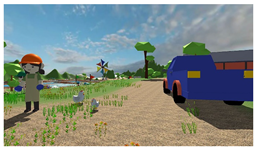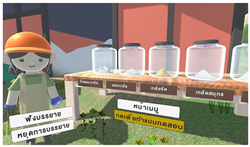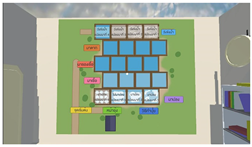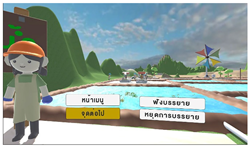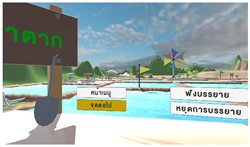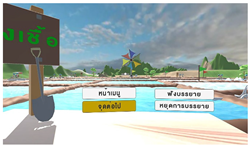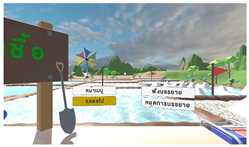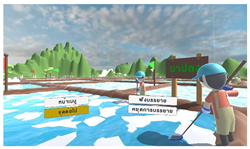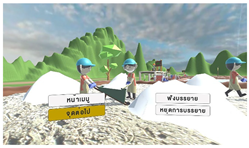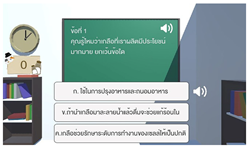Abstract
Sea salt farms are the source of salt, an indispensable essential ingredient in various foods and products. Further, they act as frontlines to protect marine disasters from entering domestic residential areas. However, sea salt farming has decreased in popularity among recent-generation farmers in Samut Songkhram Province, Thailand. This paper presents the development of an affordable virtual learning (AVL) application for Thailand’s sea salt farming. Fitts’ law was applied to optimize user-interactive objects’ size and placement to reduce selection time. The sample consisted of 127 multigenerational users, namely those in Generation X, Generation Y, and Generation Z. This study found that the developed AVL applied Fitts’ law to be used harmoniously with VR economical equipment. A total of 90.55% of multigenerational users were satisfied with the developed AVL. The “Looking” and “Executing by eye focus” activities were enjoyed by 100% of participants. The following activities were “Walking” and “Listening”, with 82.68% and 77.95% enjoying them, respectively. Generation Z users responded more to the “Walking” activity than Generation X and Y users. In addition, the hypothesis testing result of learning outcomes through AVL was consistent among multigenerational users. Therefore, the developed AVL should be used as a medium to conserve sea salt farming in Thailand.
1. Introduction
Most sea salt farming is processed in three provinces in the lower central region of Thailand, including Phetchaburi, Samut Sakhon, and Samut Songkhram. In particular, villagers in Samut Songkhram Province have been engaged in sea salt farming since ancient times. The wisdom of salt farming has been passed on continuously from generation to generation. The sea salt farming method uses natural methods that are local occupations appropriate to the area’s geographic conditions and people’s way of life. This results in obtaining natural products from the local area that have not been processed and are friendly to the environment and consumers. However, the expansion of the economic sector, industry, tourism, and the expansion of urban communities have affected areas that used to farm salt in Samut Songkhram Province. As a result, the area for sea salt farming has begun to decrease continuously. In the beginning, villagers had a career in sea salt farming. There is an area for sea salt farming in Bang Kaeo Subdistrict, Samut Songkhram Province, which is approximately 7296 rai (approximately 11.67 square kilometers) [1]. However, in 2022, only 53 households were still farming salt in an area of 2532 rai [2]. It resulted in losing the championship of sea salt farming at rank number one in the past and dropping to number three in Thailand. Making a career in salt farming requires patience and hard work to obtain salt. This causes the next generation to change to other occupations, such as working in industrial plants or, worst of all, selling sea salt farming land to obtain a lump sum of money. Suppose there is no dissemination of information to preserve the knowledge and wisdom of sea salt farming of previous generations, which has existed for a long time. In that case, the sea salt farming profession will quickly disappear. The disappearance of the main occupation in the subdistrict is considered a big problem that will affect the wisdom of sea salt farming, which has been passed down for a long time. Therefore, if sea salt farming is not disseminated, the wisdom of knowledge will not be preserved. This will significantly impact the amount of salt produced and its effect on food ingredients and other salt-containing products. Furthermore, it will result in no more salt fields as a natural coastal disaster protection line. Another meaningful impact is the destruction of Thailand’s overall coastal ecosystem.
Today, visual technology helps learners achieve more effective learning outcomes [3]. Virtual learning technology especially helps learners have an immersive experience while using it. Thus, virtual learning technology is considered a tool that helps preserve and transfer knowledge in sea salt farming, the lifestyle of farmers who farm salt, and local wisdom in salt farming through awareness. It is a virtual experience where users can immerse themselves in salt farming. The number one key to effectively presenting information is an engaging presentation. Traditionally, the conveyance of information has relied upon written and audio-visual media presented via screens. While these conventional modalities have historically proven effective, the advent of virtual reality (VR) technology introduces a paradigm shift in content dissemination. VR engrosses its users by emulating sensory perception, encompassing sight, touch, audio, and olfaction [4]. Forecasts indicate a notable surge in the global VR industry, with projections estimating its value to surpass USD twelve billion by 2024, up from less than USD five billion in 2021 [5]. Empirical studies, exemplified by some research, reveal a substantial increase in viewer engagement with VR animations compared to conventional audio–visual mediums [6]. This underscores the aptitude of VR as a conduit for information dissemination, particularly concerning indigenous knowledge, such as the intricate practices of sea salt farming, which can be preserved and cultivated through immersive educational encounters. With its widespread accessibility and capacity to evoke delight and innovative encounters through visual reality, VR presents a promising avenue for imparting the significance of vocations like sea salt farming to future generations.
Currently, VR headsets are costly because they have individual controllers separated from the saccade target selection. If the budget is limited and there are many learners or users, using VR glasses or VR boxes that use smartphones as display devices is a suitable option for affordable virtual learning (AVL) technology. However, the design of the placement of interactive objects or user interfaces requires excellent attention because all environmental control relies primarily on eyes and perspective. If the user is immersed for a long time, it may cause side effects such as dizziness. Therefore, good design of the position of the interactive objects can reduce the time spent on saccade target selection, which in turn can reduce the usage time. Fitts’ law is a predictive model of human movement primarily used to calculate the time required to move to a target area, such as a button or control. It is based on the idea that the time to acquire a target is a function of the target’s distance and size. By applying Fitts’ law, designers can determine the optimal size and placement of interactive elements (like buttons, menus, or objects). Targets of appropriate size that are closer to the user are easier and quicker to select, reducing the effort required for interaction, which is especially important in VR, where precise hand or gaze control can be challenging. When targets are appropriately sized and placed according to Fitts’ law, users can interact with the VR environment more intuitively and with less cognitive strain, leading to a smoother experience.
As mentioned above, this research uses AVL technology to educate about sea salt production in Samut Songkhram Province, Thailand. By developing immersive VR experiences, the study aims to transmit knowledge about the sea salt farming process, ensuring its sustainability for future generations. Through virtual interactions and immersive learning environments, individuals can deepen their understanding of sea salt production, contributing to preserving and advancing agricultural practices in coastal regions. This work will explore how sea salt farming virtual learning research can help disseminate immersive information and foster learning about sea salt farming across multigenerational users in Thailand by improving Fitts’ law approach. This is for learners no older than 60, consisting of three user generations: X, Y, and Z. However, many studies define different age ranges for each generation (Gen). As Koudal and Chaudhuri [7] point out, Gen Y (people born between 1982 and 1993) value and enjoy innovation. According to Caserman et al. [8], Gen X people were born between 1965 and 1978, while Gen Z people were born between 1995 and 2009. They prefer solutions, knowledge, and new things that are different and have more opportunities to try to become addicted to new things than Gen Y and Gen X. On the other hand, Slepian et al. [9] defined Gen X, Y, and Z age ranges as those born between 1965 and 1980, 1981 and 1996, and 1997 and 2012, respectively. This work classifies Gen X based on the classification according to [8,9]. Gen Y and Z are based on the classification according to [8]. Therefore, the age ranges of Gen X, Y, and Z are those born between 1965 and 1979, 1980 and 1994, and 1995 and 2009, respectively.
It is imperative to study the suitability and acceptance of virtual media for sea salt farming by people of each generation. This research hypothesizes that young people, especially Gen Z representatives, will prefer virtual media more. They still tend to use virtual media more than other generations and want to discover obstacles that will arise from using VR. To explore the acceptance of virtual reality media for sea salt farming, this research involved a comprehensive study of focus group discussions, prototyping virtual media, and studying age groups involving Gen X, Y, and Z users. The research aims to examine a wide range of aspects, from concrete design issues to adoption across generations. It aims to answer two important research questions as well:
- (1)
- How can Fitts’ law be applied to saccade target selection, which is used with VR economical equipment?
- (2)
- To what extent is AVL of sea salt production accepted in practice by different generations between Gen X, Y, and Z?
The study’s results include proposed design suggestions. These should help future designers and developers better understand how to use virtual reality to disseminate marine agricultural information across generations. This paper is organized into seven sections. The Related Work section refers to various research works. The research methodology will be explained in the Material and Methods section. The Results section presents the results of the study on the developed AVL using Fitts’ law and applies them to a sample group. The following section is the Discussion, and the Conclusions section summarizes the research results. The last section is Final Considerations and Future Work, which provides guidelines for further research studies, development, and extension.
2. Related Work
Virtual learning has shown its potential to revolutionize agricultural education in diverse ways. By immersing students in virtual learning environments, VR promotes plant learning, offering immersive and otherwise challenging experiences. This immersive environment allows learners to explore the intricate structures of crops, fostering a more profound interest among agricultural students [10]. VR extends beyond plant education, with specific research dedicated to leveraging this technology for teaching sustainable management of locusts, a prevalent agricultural pest [11]. This approach addresses the pressing issue of locust infestations, which jeopardize food security in numerous African and Asian countries. By simulating locust management scenarios, VR eliminates the need for environmentally harmful pesticides, offering a safer and more sustainable solution. Additionally, VR’s interactive storytelling method enhances user engagement, facilitating the adoption of sustainable pest control practices. Learning to use machinery and heavy equipment is a top priority in agriculture. VR is valuable for training farm machinery technicians and users, addressing safety concerns, and enhancing operational efficiency [12]. Through immersive simulations, users can acquire essential skills and maintenance knowledge in a risk-free environment, reducing the occurrence of farm accidents. Unlike traditional training methods, VR offers a cost-effective and globally accessible solution, accommodating users worldwide through its multilingual interface. In addition, VR has been used to enhance consumer confidence in agricultural products. Virtual farm simulations provide insights into farming practices and food production processes [13]. By offering a realistic farm experience, VR fosters transparency in the agri-food system, mitigating consumer concerns and fostering trust in the agricultural industry.
As global and environmental challenges continue to impact food security, VR emerges as a vital tool for advancing sustainable agriculture practices [14]. By transcending physical limitations, VR platforms facilitate knowledge transfer and innovation among farmers, promoting urban agriculture as a critical component of smart city technology. Through collaborative efforts with land-grant universities and farmer networks, VR can address urban and rural communities’ food security and equity concerns. In summary, integrating VR technology across various facets of agriculture signifies a transformative shift towards more efficient, sustainable, and transparent agricultural practices. The study by Kumari et al. [15] explores the potential of VR technology to revolutionize progressive farming in emerging economies. By conducting a perception study among stakeholders such as farmers, groups, and cooperatives, the research investigates future perspectives on adopting VR technology for sustainable agricultural production. The consultation with academic experts led to an updated framework, highlighting the importance of VR technology in maintaining quality and knowledge in sustainable agricultural practices, particularly in emerging economies. In Europe, Grivokostopoulou et al. [16] emphasize the transformative impact of VR on agricultural education and entrepreneurship. VR is an innovative educational platform that empowers young people to engage in agriculture-related entrepreneurship. Through advanced ICT-based methods like 3D virtual reality, learners acquire practical skills and theoretical knowledge in a dynamic virtual environment [17,18]. Interactive learning activities and simulations foster critical thinking, creativity, and problem-solving skills, positioning VR as a valuable tool for cultivating agricultural expertise. However, a few studies have shown that improving usage time by designing interactive objects of the right size and placement can help users spend the least time and reduce the dizziness effect of immersive technology.
3. Materials and Methods
The process of developing the affordable virtual learning technology of sea salt farming across multigenerational users consists of eight processes: focus group, survey process, design framework, application of Fitts’ law to write control programs for saccade target selection, AVL development, equipment, participants, and measurement, as shown in Figure 1.
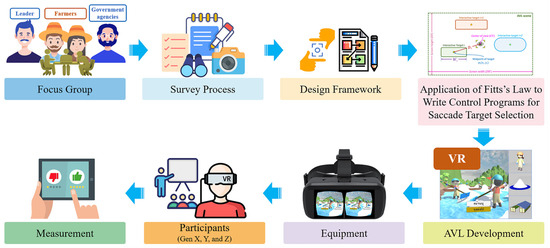
Figure 1.
The process of developing the affordable virtual learning technology of sea salt farming.
3.1. Focus Group
Samut Songkhram Province used to be number one in sea salt production but has now fallen to number three in Thailand, where sea salt farms have significantly decreased in this area. The Samut Songkhram Provincial Sea Salt Confederation is a group representing the leading salt farmers in Samut Songkhram Province. They are considered the owners of the salt fields, experts in salt farming, and direct stakeholders in the sea salt business. Therefore, this research was conducted in a focus group with government agencies, community leaders, village headmen, farmers, the Samut Songkhram Provincial Sea Salt Confederation, and teachers’ representatives in the sea salt field area, Bang Kaeo Subdistrict, Samut Songkhram Province, Thailand, as shown in Figure 2. This focus group focuses on collecting information, content moderation, and the order of telling the story of sea salt farming to develop virtual reality media into a suitable medium for disseminating information. By creating an experience by presenting fresh and fun content, AVL simulates the user’s senses, including seeing, touching, and hearing, better than disseminating information using written and audio–visual media displayed on the screen, although these methods may have been considered appropriate in the past.
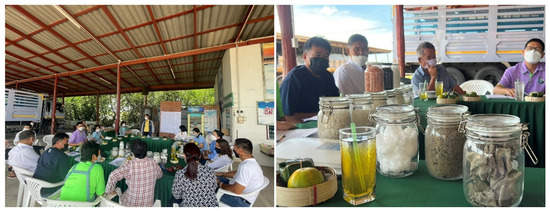
Figure 2.
Focus group for collecting information on sea salt farming and production.
3.2. Survey Process
The survey is to collect data on sea salt fields in Samut Songkhram Province, such as seawater through to the salt field, salt field environment, materials, equipment, storage location, and the process of sea salt farming. The researcher visited all ponds according to the cycle of the sea salt farming process, including the stabilization pond, evaporation pond, concentration pond, crystallization pond, and harvest pond, as shown in Figure 3. These surveys include the period of sea salt farming without activities to develop an AVL for sea salt production in a nature classroom in Samut Songkhram Province to present content that all age groups can understand.
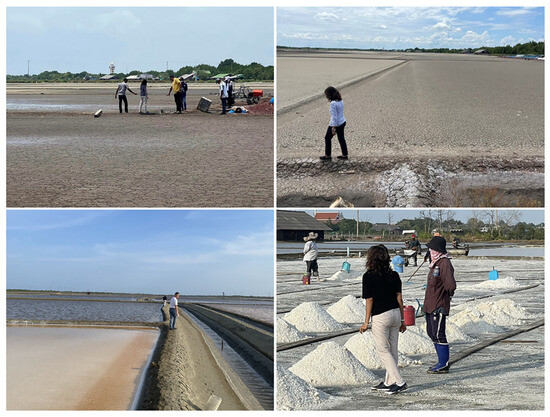
Figure 3.
The survey of the target sea salt areas covers the entire process of salt farming from the beginning to the harvest of sea salt.
3.3. Design Framework
This research framework consists of the AVL experience, which utilized principles from narratology, VR environment, and the pyramid of learning, supplemented by engaging activities to captivate the audience, as illustrated in Figure 4.
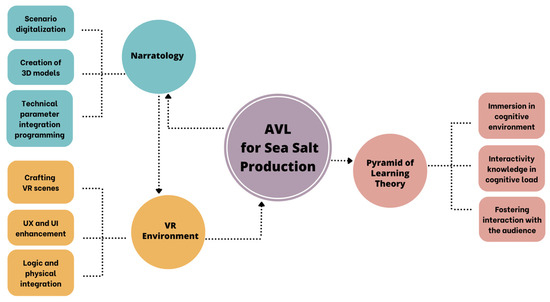
Figure 4.
The AVL for sea salt production framework.
3.3.1. Narratology
Narratology or storytelling is a tool for spreading community narratives about sea salt production. It is poised to illuminate further the intricate narratives of sea salt production in Samut Songkhram Province. The essence of narrative can be encapsulated in one fundamental question: “Who narrates what and how?” The narrator could be a writer, an artist, a sculptor, or any other imaginative creator. The choice between a first- or third-person perspective is at the author’s discretion [6,19]. For this research, the investigator adopted a first-person narrative approach as the sea salt farmer, immersing the viewer as the protagonist within the VR environment by creating scenario digitalization through the creation of 3D models and technical parameter integration programming, which is the design of the part that will control the commands in the user interface through devices.
3.3.2. VR Environment
Based on the findings in narratology, the development of the VR environment was structured into three main components: (1) Crafting VR scenes involved amalgamating 3D models to construct comprehensive arenas within each scene, aligning them with the narrative sequence of 10 scenes about sea salt farming in Bang Kaeo Subdistrict, Samut Songkhram Province, Thailand. (2) User experience (UX) and user interface (UI) enhancement: This focuses on prioritizing aesthetics and usability. Each scene underwent meticulous development to ensure user engagement through UX and UI design. Given the novelty of learning with VR, special consideration was given to creating an intuitive control interface to navigate the technology seamlessly. (3) Logic and physical integration: This phase focused on devising a set of commands and player movements tailored to each scene. These commands encompass actions such as listening, looking, walking, and executing by eye focus within the virtual space by applying Fitts’ law to possibly create commands that drive the selection of saccade targets that are activated by viewing the desired menu item and holding the activated object by eye focus, which is suitable for VR economical equipment.
3.3.3. Pyramid of Learning Theory
When the media creation is more captivating, the audience comprehends and retains information better. The types of engagement can be categorized into three levels: symbolic experience, iconic experience, and direct and purposeful experience [6,20,21]. In this approach, this work focuses on immersing learners in the virtual experience of sea salt production through three key components developed to create an immersive cognitive environment. This involves simulating a real-world environment to immerse users in knowledge. Users actively engage with the content through interactive knowledge on their cognitive load and fostering interaction with the audience, creating a “contrived experience”, which falls under the direct and purposeful experience category and is considered highly effective in education.
According to Figure 4 and the above discussion, these three principles are integrated into the AVL framework to create a comprehensive learning experience. Narratology provides the narrative context and storytelling, the pyramid of learning serves as a guide for structuring the educational content of knowledge to ensure that learners build a strong foundation before moving onto more advanced topics, and the VR environment offers an immersive platform for learning in the digital space where learners can interact with educational content in a simulated, often 3D, environment. Therefore, the overall knowledge content is arranged as a story of salt production based on narratology in an immersive learning format in a VR environment, with the complexity of the content from easy to difficult, in the order of the steps of the pyramid of learning. Together, they make education affordable, highly effective, engaging, and accessible to a broader audience. This approach can be precious in distance education, professional training, and any context where traditional learning methods may be limited by resources or accessibility.
3.4. Application of Fitts’ Law to Write Control Programs for Saccade Target Selection
The research focuses on developing VR technology that is compatible with affordable wearable devices and does not have peripherals as a command part, emphasizing simplicity in command functions. The aim is to facilitate convenient access to virtual environments. Consequently, this research employs Fitts’ law to formulate commands enabling users to select menus and activable objects by maintaining their gaze for a duration of two seconds [22,23,24,25]. The mathematical equation for Fitts’ law to calculate the index of difficulty () and the movement time () is formulated in (1)–(3) [23,25] and illustrated in Figure 5.
where

Figure 5.
The Fitts’ law applied to the UX and UI design of the AVL scene.
—represents the movement time (typically in milliseconds) to a target;
—represents the index of difficulty in logarithmic term of the width and distance of a target;
—represents the intercept coefficient (where = 0);
—represents the slope coefficient;
—represents the distance between the center of view and the midpoint of a target;
—represents the width of a target.
According to Fitts’ law, this research has improved the size and position of various objects in the AVL scenes, effectively reducing each object’s saccade selection time by calculating the total movement time () for accessing all targets or objects, such as a menu arranged in non-overlapping positions, based on the probability of placing multiple objects in a scene. Then, the probability placement of each target should be optimized for size and placement, which were simulated depending on the shortest time () for saccade target selection by gaze controlling the user’s eyes on an AVL scene as in (4) and (5) and the following Algorithm 1:
where
—represents the probability of placing the i-th interactive target in a scene;
—represents the total number of interactive targets in a scene.
| Algorithm 1: Fitt’s law for UX and UI design of saccade target selection in VR scene |
| Input: |
| number of target N |
| probability of placing all targets P |
| screen width SW |
| screen height SH |
| intercept coefficient a |
| slope coefficient s |
| Initial: |
| Set x = SW/2 |
| Set y = SH/2 |
| Set center of view CV = point(x,y) |
| Set the shortest time st = infinity |
| Set the shortest point in array pst(x,y) |
| For m = 1 to P do: |
| Set the total movement time Tm = 0 |
| For i = 1 to N do: |
| Set Wi = getWidth(target i) |
| Set pi(x,y) = getMidpoint(target i) |
| Set Di = getDistance(target i, pi(xi,yi)) |
| Set MTi = calMT(a, s, CV, Wi, Di) |
| Set Tm = Tm + MTi |
| IF Tm < st then: |
| Set st = Tm |
| For i = 1 to N do: |
| Set pst(xi,yi) = p(xi,yi) |
| End for |
| Output: the optimized shortest time st, shortest point pst(x,y) |
3.5. AVL Development
The AVL development process adheres to the established scope of the design framework. This work has meticulously crafted a VR environment to narrate the sea salt production process following the principles of narratology, refined through focus group discussions. Each scene within this environment is optimized for virtual reality, ensuring a seamless user experience and smooth operation. This is complemented by intuitively designed UX and UI elements, including descriptive sound and programming a set. Furthermore, a series of instructions were encoded to streamline tasks, enabling learners to follow the pyramid of the learning model. This immersive learning experience fosters engagement and interactivity with virtual media while utilizing affordable VR equipment. Consequently, agriculture learning about sea salt production in a virtual natural classroom becomes accessible, transcending geographical limitations (see Table 1).

Table 1.
Audience guidance, AVL scene, and type of audience physical activity.
AVL development utilizes Blender (version 2.9) and Unity (version 2022.3.20) software. Blender is employed for designing and developing three-dimensional objects (3D objects) and crafting scenes based on storytelling [26]. Unity, on the other hand, serves as a platform for creating virtual reality applications. It enables the implementation of commands for controlling operations such as gaze-based interactions and object manipulation, facilitating integration with devices for navigating virtual environments. These tools seamlessly integrate elements, 3D objects, and storytelling content into applications tailored for the Android operating system.
The developed AVL was evaluated based on the index of item-objective congruence (IOC) of the contents, presentation format, and application for each AVL scene by ten experts in information technology and education technology before deployment. The IOC evaluation threshold value is 0.5 and above (the maximum is 1.0), which means that the evaluation criteria are met and can be implemented further [27]. The IOC of this developed AVL evaluation result was equal to 0.8, which is appropriate for use in all three generations.
3.6. Equipment
The AVL application developed in this project is compatible with smartphones running the Android operating system version 11 or higher or API level 30 or higher. It requires approximately 100 megabytes (MB) of storage space for installation and requires external speakers or wired/wireless headphones for audio playback. For optimal virtual reality usage, efficiently and without too high equipment costs, the VR application can be installed on a smartphone equipped with virtual reality glasses (VR glasses) that support Google Cardboard from version 1 onwards [28]. Alternatively, users can utilize a virtual reality box (VR box) designed with compartments to hold smartphones or portable devices securely [29] (see Figure 6).
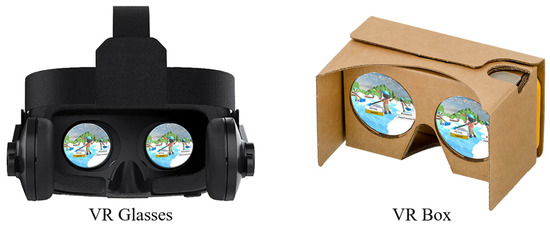
Figure 6.
The economical devices for AVL.
3.7. Participants
Participation was entirely voluntary. The study was promoted on social media platforms, and applications were collected through Google Forms for ninety days to recruit a sample group. This was aimed at residents of Samut Songkhram Province and neighboring provinces, those involved in the sea salt farming profession, and those interested who were born between 1965 and 2009 for Gen X, Y, and Z. A total of 127 participants engaged in virtual experiential learning related to sea salt production; of the participants, 57 were women (44.88%), 65 were men (51.18%), and 5 identified as other genders (3.94%), as in Table 2. Before participation, participants were briefed on the study objectives, and consent was obtained while concealing ethical information to ensure unbiased consent and ethical permission. Specifically, 20 were Gen X (15.75%), 34 were Gen Y (26.77%), and 73 were Gen Z (57.48%). In the Gen Z group, in cases where research participants were under 18 years of age, parental consent was obtained for research, which is considered to protect the rights of minors. Participants were categorized into three age groups, as detailed in Table 3.

Table 2.
Distribution of the sample based on gender frequencies and percentages.

Table 3.
Distribution of the sample based on generation frequencies and percentages.
3.8. Measurement
This work used the “observation and questionnaire form” to collect data for measurement. The observation form was crafted for staff members to document audience behavior, covering aspects like the audience’s adherence to instructions for each action and the provision of assistance if they encountered difficulties during the process. The survey by questionnaire employed the Likert scale [30,31] to gauge respondents’ views on aesthetic and overall experience satisfaction. Participants could rate using a four-point Likert scale from one (strongly disagree) to four (strongly agree) without considering unbiased opinions because the impartial values do not produce a clear enough positive or negative performance measure. This can reduce respondents’ tendency to select a neutral option, thus encouraging them to make a more definitive choice than a five-point Likert scale. The interpretation of results in this evaluation has only two values: satisfied (if the user selected strongly agree) or unsatisfied (if the user selected disagree or strongly disagree) to obtain clear and easily understandable VR performance results, as shown in Table 4. In addition, the participants could provide additional comments or observations about AVL and utilize free-text fields for input.

Table 4.
The four-point Likert scale level for evaluation.
Further, five experienced information technology or agriculture professionals related to sea salt farming reviewed and confirmed the research tools, such as the user satisfaction form, yielding an IOC of more than a score of 0.81 (threshold = 0.5). After immersion in the virtual reality playhouse, audience members underwent an assessment comprising ten questions. These inquiries serve to evaluate the audience’s grasp of the subjects of sea salt production.
Furthermore, in this research, the Kruskal–Wallis test [32] was applied to test the consistency of learning outcomes for equal sample sizes and was used for the hypothesis test [33]. It is a non-parametric method used for hypothesis testing, particularly when comparing three or more independent groups. The Kruskal–Wallis test is more general than other techniques, which compare only two groups. This test is a flexible and robust alternative to parametric tests like ANOVA, especially when the data do not meet the assumptions of normality or homogeneity of variance.
4. Results
4.1. The Sea Salt Production AVL Experience
Each participant’s AVL session lasted 4 min and 47 s, during which they were actively immersed in the virtual environment, experiencing reality, and capable of independently following voice-over instructions. Participants could manually turn the voice-over on or off by selecting the virtual speaker menu and looking at the menu for two seconds. The 127 spectators were immersed in the AVL of sea salt production learning, as in Figure 7.
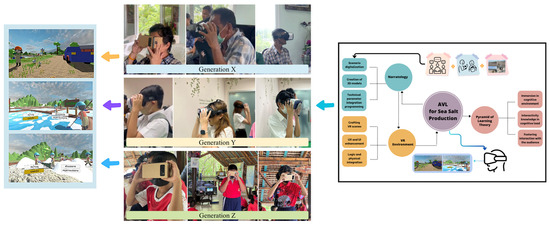
Figure 7.
The three generations of spectators are immersed in the AVL of sea salt production learning.
Figure 7 delineates the frequency (F) and proportion of the sample’s capacity (percentage: P) to engage independently in various AVL tasks. These tasks are categorized into three groups: visual exploration, movement, and menu selection through gaze fixation lasting two seconds. This classification encompasses ten distinct AVL tasks. This study has four assistants in various roles: one facilitated by furnishing information and maintaining proximity during the participants’ engagement in the virtual experience. Another oversaw audience behavior during play, while two assistants administered and retrieved questionnaires, guiding to ascertain the listener’s comprehension level. In addition, participant behaviors were grouped into four AVL activities: walking, looking, listening, and executing by eye focus.
Results from studying the behavior of all participants found that approximately 105 out of 127 participants (82.68%) could independently participate in “Walking” activities on average, with Gen Z exhibiting the highest walking percentage (91.78%). All 127 participants (100%) displayed the capability to actively engage in “Looking” and “Executing by eye focus” activities autonomously. Additionally, 99 participants (77.95%) were proficient in participating in “Listening” activities without the need for staff assistance, with Gen Y showing a listening percentage (85.29%) greater than Gen Z and Gen Y. Moreover, when asked which activity within the virtual reality experience they enjoyed the most, the audience rated “Looking” and “Executing by eye focus” as the most enjoyable activity at a frequency of 127 (100%). The comparison result of the capability to actively engage is shown in Figure 8. In addition, the frequency and proportion of the sample’s capacity to engage autonomously in ten distinct AVL tasks are summarized in Figure 9. Considering each AVL task, it was found that the “Step up to enter the sea salt fields” and “Take the exam on the sea salt topic” tasks were the most engaging for all generations, accounting for 100%. The experiment results overall found that Gen Z most enjoyed the AVL tasks, with a mean value of 91.78%. Next were Gen Y and Gen X, with mean values of 88.24% and 77.50%, respectively.
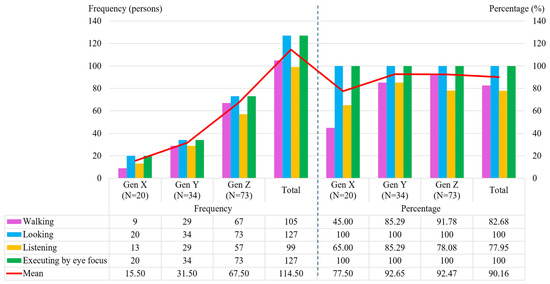
Figure 8.
The comparison of frequency and percentage of each generation enjoyed in AVL’s four activity groups.
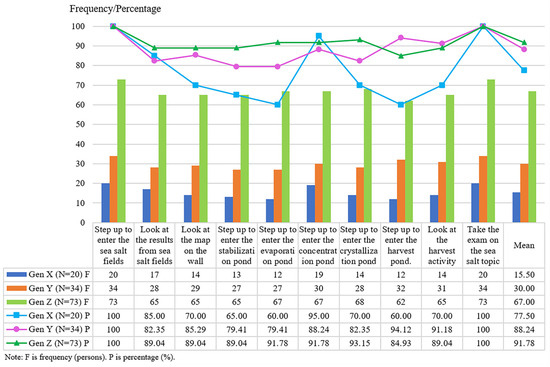
Figure 9.
The frequency and percentage of each generation engaged in AVL’s ten activities.
4.2. The Efficacy of the Sea Salt Production AVL Experience
This study evaluates the efficacy of AVL technology based on the contentment levels of a sample comprising 127 individuals, with the result shown in Table 5. This result found that participants across multiple generations expressed complete satisfaction with the visual aspects of the AVL encounters. Most participants derived pleasure from the AVL encounter and commended the straightforward design. However, a minority—comprising 12 individuals: 4 of Gen X (20%), 2 of Gen Y (5.88%), and 6 of Gen Z (8.22%)—endorsed the scale anchor of disagree, with none expressing complete disappointment.

Table 5.
Frequency and percentage of satisfaction level of AVL activities.
Nevertheless, there were 12 instances in which dissatisfaction among the audience was prevalent. The participants probably experienced nausea during the encounter, a condition associated with AVL that can be influenced by factors such as age, gender, hardware, and the content itself [6,31]. This is also why some people wear eyeglasses, which can be inconvenient when using VR equipment. Nonetheless, this aspect falls beyond the purview of this study.
Moreover, when assessing the coherence of viewpoints regarding viewers’ satisfaction ratings, it was discerned that all cohorts exhibited uniform opinions across the four essential activity categories within the AVL encounter, with no instances of interquartile range (IQR) values and quartile deviation (QD) exceeding the threshold of 1.0 within any group (see Table 6).

Table 6.
The consistency of opinions in satisfaction evaluation.
4.3. The Accuracy of AVL for Sea Salt Production Learning
This research applied the confusion matrix table to measure the accuracy of the developed AVL for sea salt production learning among user satisfaction levels that reflect the accuracy of AVL use through the user’s perspective. The satisfaction evaluation results of AVL users of all three generations (127 participants) in Table 5 were used to calculate the accuracy of the developed AVL in the normalized confusion matrix, as shown in Figure 10, where 1.0 is equivalent to 100% of all participants. The normalized confusion matrix shows that Gen Y users are satisfied, with the highest accuracy of 94.12%; meanwhile, Gen Z and Gen X users are satisfied, with an accuracy of 91.78% and 80.00%, respectively. Overall, the user was satisfied that the developed AVL had an accuracy of 90.55%. In comparison, the users were unsatisfied with a false negative of 7.09% and a false positive of 2.36%. These results show that the developed AVL is accurate and satisfies the users in this study.
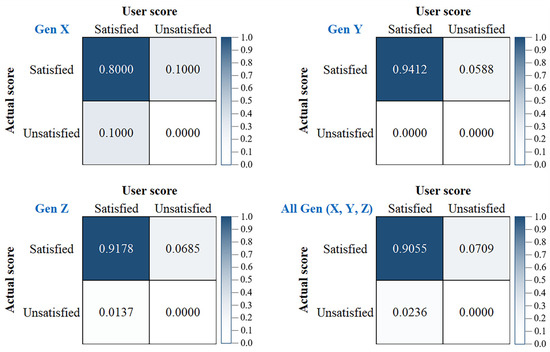
Figure 10.
The accuracy of AVL for sea salt production learning according to the normalized confusion matrix.
4.4. The Efficacy of the Devices in an AVL for Sea Salt Production
The research examined the efficacy of two distinct VR devices, namely VR glasses and the VR box, in facilitating participants’ engagement in an AVL for a sea salt production experience. The developed AVL applied Fitts’ law to design interactive objects using saccade target selection for working VR economical equipment instead of expensive VR headsets with hand controllers. The study, involving 127 participants, revealed notable preferences among different generational groups. Specifically, within Gen Y, 23 individuals (67.65%) favored VR glasses, whereas among Gen Z, 37 participants (50.68%) preferred the same device. Conversely, only four individuals from Gen X (20%) favored VR glasses. In contrast, within Gen X, the VR box garnered an 80% preference rate (16 individuals), surpassing the preference rates among Gen Z (49.32%, 36 individuals) and Gen Y (32.35%, 11 participants), as shown in Table 7.

Table 7.
The frequency and percentages of each generation using equipment.
Based on the interview findings and participant feedback analysis, it was discerned that individuals favor the VR box primarily due to its comfortable fit, as it does not exert excessive pressure on the head. Moreover, those who wear eyeglasses appreciate VR boxes because they accommodate their glasses without causing discomfort, enabling them to partake in AVL activities comfortably. Additionally, Gen X favors the VR box owing to its cost-effectiveness and do-it-yourself potential, presenting an economical and environmentally friendly option. Conversely, Gen Y and Gen Z prefer VR glasses due to their ability to adjust viewing distance, enhancing image sharpness according to their preferences.
4.5. The Results of the Hypothesis Test
Findings from examining the hypothesis of the consistency of learning outcomes of the sample are shown in Table 8, which summarizes the statistics for the hypothesis of the consistency of learning outcomes of three generations. The results of testing the hypothesis of the consistency of learning outcomes through virtual experiences are shown. The assumptions are set as follows.

Table 8.
Results of the learning outcome consistency according to the Kruskal–Wallis test (confidence level = 0.05).
H0:
The results of learning about salt farming from three generations are consistent.
H1:
The results of learning about salt farming from three generations are inconsistent.
The result is based on the ranking (rank) of the results of the salt farming learning test from all three generations, consisting of Gen X, Y, and Z. The significance level (α) was set to be equal to 0.05 (confidence level was 95%). The results from the Kruskal–Wallis test found that the H-statistic (H-stat) value was 2.19389, the H-ties value was 2.70858, and the p-value was 0.25813. It can be seen that the H-stat value and H-ties are less than the critical value in the Kruskal–Wallis tabulated value. Further, the p-value was greater than the significance level (0.05). Thus, the null hypothesis was accepted. Therefore, the results of learning about salt farming from all three groups were consistent.
4.6. Suggestions Based on Findings
Qualitative research results from observation during activities and answering open-ended questionnaires from the AVL participants facilitated the collection of feedback from the sample group. Then, five experts in information technology and education technology analyzed all of the data from the focus groups. The focus group results can be summarized as recommendations as follows.
- (1)
- Gen X: Offering VR equipment tailored for the elderly is advisable, given that most elderly individuals wear glasses and encounter more vision-related issues than other age demographics. The AVL experiences are desired to closely mimic the ambiance of an authentic sea salt field.
- (2)
- Gen Y: There is a desire for AVL to offer diverse content, as the prospect of learning with AVL is inherently thrilling. Certain users experience dizziness during extended AVL sessions due to their lack of familiarity with the technology.
- (3)
- Gen Z: They desire to engage in frequent AVL activities across various topics. Feedback from individuals under 11 years old suggests a limitation stemming from the inability to access AVL apps on mobile phones due to parental restrictions.
The conclusions and recommendations from the sample groups are in the same direction. Some users may experience dizziness when they experience AVL for the first time. However, with subsequent use, this sensation diminishes. Users are impressed by the VR content and want it to be available in various content ways. The study also recommends that VR equipment be available that is suitable for people who wear eyeglasses, especially the elderly.
5. Discussion
This study aims to develop economized virtual learning resources for sea salt farming in Samut Songkhram Province, Thailand, which will lead to the preservation of the wisdom of traditional practice, safeguarding of the associated expertise to ensure its continuity as a local profession, and preservation of the natural coastal disaster protection line, which is another pride of all salt farmers, and the overall coastal ecosystem of Thailand in a sustainable way. Our findings expand on previous work [6,10,11,12,13,14,15] by developing a focus point for commanding the gaze to command AVL and exploring the acceptance of AVL technology as knowledge dissemination media for sea salt production across diverse age groups and challenges in its integration dissemination into sea agriculture. This research sheds light on crucial aspects of VR adoption in this domain. The Fitts’ law approach was applied and improved to find the suitable size and placement for all interactive objects in AVL scenes. The probability placement of each target should be optimized for size and placement, which were simulated based on the shortest time (st) for saccade target selection by gaze controlling the user’s eyes on an AVL scene. A necessary requirement is that interactive objects should not be too large to obscure the main content and should not overlap.
The study, involving 127 participants, produced intriguing findings. Notably, the primary outcomes unequivocally address the first research question, which focuses on the activity preferences of different generations (Gen X, Y, and Z) regarding AVL activities related to sea salt farming. It was observed that every generation exhibited the highest engagement in activities such as “Looking” and “Executing by eye focus”, which serve as foundational interfaces for subsequent tasks, necessitating visual acuity from the outset. Gen Z shows a pronounced preference for walking activities, aligning with the findings of other research work [11] and supporting the hypothesis of this research, which posits that young individuals, especially those in Gen Z, exhibit a growing affinity for virtual media. They are notably more inclined than other generations to participate in virtual media events, underscoring their receptivity to such technological mediums. Regarding the content topics, it was observed that all three generations show the highest participation rates in activities related to “Step up to enter the sea salt fields” and “Take the exam in sea salt topic”. This trend can be attributed to the pivotal role of “Step up to enter the sea salt fields” as the initial gateway into the virtual environment, allowing participants to select their learning trajectory. Conversely, “Take the exam in sea salt topic” presents a challenge that prompts participants to apply their acquired knowledge and skills, effectively concluding the session. This observation aligns with the Serial Position Effect theory in user experience design [34], which suggests that individuals tend to remember the first and last elements encountered. However, it is noteworthy that Gen X exhibited the lowest participation rates in walking activities compared to other tasks. This discrepancy may stem from health-related concerns, such as reluctance to engage in physical movement or experiencing dizziness while using AVL technology, which could deter specific individuals from participation.
This study has addressed the second research question, examining the extent of acceptance of AVL technology in the context of sea salt farming across different generational cohorts. Utilizing predetermined criteria for AVL acceptance, participants indicating “Strongly Agree” or “Satisfied” were deemed to embrace the virtual reality experience, while those selecting “Disagree” or “Strongly Disagree” were categorized as non-accepting of AVL as a learning tool in sea salt farming. The findings revealed a noteworthy trend across all generations, with over 80% expressing strong acceptance. At the same time, a minority endorsed “Disagree”, and no participants indicated “Strong Disagree”. Moreover, this study has revealed a noteworthy consideration regarding the importance of VR equipment suitability for Gen X, Y, and Z. Specifically, participants with vision impairments, such as nearsightedness or farsightedness, preferred VR boxes that accommodated their glasses. Their inclination towards these AVL setups stems from a desire for enhanced visual clarity during AVL experiences and a reluctance to remove their glasses while engaging in AVL activities.
As this study encompassed participants spanning three distinct age demographics, it offers valuable insights into the acceptance of AVL within a practical sea salt farming educational setting. Consequently, it is a significant reference point for researchers facing analogous scenarios. Building upon these discoveries, the researchers present their findings on AVL and its utilization across three generational cohorts, thereby furnishing a contextual framework for prospective research endeavors. The overarching aim is to catalyze the proliferation of AVL as an educational medium, a medium for exhibitions, and a conduit for preserving and perpetuating local vocational expertise, thereby enhancing intrigue and inspiration. Effective AVL design methods are essential to ensure that the technology positively influences learning outcomes across all age groups. Recent advances in AVL technology have significantly changed human–computer interaction (HCI) [35]. Like this research, AVL technologies have transformed sea salt production learning through new human–computer interactions in different generations of people. There exists an influence of favorable educational achievements alongside emotional aspects such as motivation and enjoyment.
6. Conclusions
Sea salt is an ingredient in many products and foods. Sea salt production still requires methods and knowledge passed down from generation to generation to preserve and produce quality salt. The sea salt farming process requires farmers to tolerate the climatic conditions, and it takes a long time to produce salt crystals. In contrast, nowadays, many other careers make money quicker. This has resulted in a continuous decrease in the number of salt farmers in Samut Songkhram Province, Thailand. Further, the loss of salt farms could further reduce protection against marine disasters. Thus, this research developed AVL for sea salt farming using VR technology to transmit knowledge of sea salt farming methods. However, dizziness may occur if the learner uses immersive VR for a long time. Therefore, Fitts’ law was applied and improved to design the size and placement of interactive objects suitable for each developed AVL scene in this work. This was carried out by simulating the probability of the size and placement of each non-overlapping interactive object using a developed algorithm for each AVL scene. When the development is complete, it will be used to teach users how to farm sea salt using VR economical equipment consisting of the VR box and VR glasses. Some users are senior farmers, children of farmers, or interested people of different ages in three generations, including Generation X, Y, and Z. Thus, the developed AVL is designed to be easy to learn and suitable for learners of all three generations. The sample group in this study consisted of 127 people, divided into Gen X, Y, and Z, totaling 20, 34, and 73 people, respectively.
The results show that improved Fitts’ law can be used to design the size and placement of interactive objects in each AVL scene. The developed AVL session learning lasted 4 min and 47 s for ten distinct AVL tasks. Nevertheless, the participants can spend longer immersed in VR if they do not experience dizziness while using it. Overall, the experiment results showed that 91.78% of Gen Z enjoyed the AVL tasks. In comparison, 94.12% of Gen Y was satisfied with the developed AVL. Gen X had the lowest average engagement of the four groups of the AVL activities, at 77.50%. However, unanimity in opinion was observed among participants from each generation across all activities, indicating consistent acceptance levels. This consistency aligns with the findings of hypothesis testing using the Kruskal–Wallis test, which demonstrated non-significant differences (significance level = 0.05) in learning outcomes across generations.
Therefore, it can be concluded that the applied and improved Fitts’ law can be used to design interactive objects in AVL scenes to reduce the immersion time in VR. Moreover, The developed AVL might be used as a medium to create new learning experiences and transfer knowledge of sea salt farming. It also preserves the wisdom of sea salt farming, creates awareness, and cherishes our ancestors’ traditional way of life so that it will continue.
7. Final Considerations and Future Work
Although the study encompassed a substantial cohort of participants (n = 127), it suffered from imbalanced representation across different age groups, notably with the older Gen X demographic comprising only 15.75% of the sample, thus indicating underrepresentation. Therefore, increasing the sample size for Gen X will increase the reliability and support the experimental results better. Consequently, forthcoming research endeavors should prioritize assessing AVL experiences, mainly targeting this demographic. Future research must develop innovative algorithms through eye-hold staring tailored to different age demographics in light of the challenges associated with presbyopia among the elderly. This may include developing VR boxes and VR glasses to support users who wear glasses while using them. This will improve the efficiency of developing user experience and user interface elements that are essential to the AVL experience for this particular age group. In addition, Future studies will aim to explore in depth the factors affecting content acceptance and the usage of virtual learning resources in realistic reality and virtual reality formats for agricultural content in Thailand for each age group. Ultimately, developing scenes and environments by changing from a three-dimensional polygon to a 360-degree photographic form will allow users to immerse themselves in the real world as closely as possible.
Funding
The research was funded by the National Science, Research and Innovation Fund (NSRF), grant number 12746/2567, in the national budget of the fiscal year 2024 provided to Suan Sunandha Rajabhat University.
Institutional Review Board Statement
This study was conducted in accordance with the Suan Sunandha Rajabhat University Ethics Committee and approved by the Suan Sunandha Rajabhat University Ethics Committee, Bangkok, Thailand, COE. 2-009/2024, and authorization (protocol code 67-009-2-1 and approval date: 10 January 2024).
Informed Consent Statement
Informed consent was obtained from all subjects involved in the study.
Data Availability Statement
The data presented in this study are available on request to the corresponding author.
Acknowledgments
The author would like to thank the National Science, Research and Innovation Fund or “NSRF”, Faculty of Science and Technology, Suan Sunandha Rajabhat University, and the Institute for Research and Development, Suan Sunandha Rajabhat University, for this research opportunity and invaluable assistance.
Conflicts of Interest
The author declares no conflicts of interest.
References
- Office of Agricultural Economics. Sea Salt Production, 2021. Available online: https://oae.go.th (accessed on 18 September 2023).
- Bang Kaeo Subdistrict Administrative Organization. Bang Kaeo Subdistrict Area, 2022. Available online: http://www.bangkaewsamutsongkhram.go.th/site/ (accessed on 18 September 2023).
- Nuanmeesri, S. Developing gamification to improve mobile learning in web design course during the COVID-19 pandemic. Int. J. Inf. Educ. Technol. 2021, 11, 567–573. [Google Scholar] [CrossRef]
- Andonova, V.; Reinoso-Carvalho, F.; Ramirez, M.A.J.; Carrasquilla, D. Does multisensory stimulation with virtual reality (VR) and smell improve learning? An educational experience in recall and creativity. Front. Psychol. 2023, 14, 1176697. [Google Scholar] [CrossRef] [PubMed]
- Statistica. Virtual Reality (VR)—Statistics & Facts, 2021. Available online: https://www.statista.com/topics/2532/virtual-reality-vr/ (accessed on 18 September 2023).
- Karnchanapayap, G. Activities-based virtual reality experience for better audience engagement. Comput. Hum. Behav. 2023, 146, 107796. [Google Scholar] [CrossRef]
- Koudal, P.; Chaudhuri, A. Managing the Talent Crisis in Global Manufacturing: Strategies to Attract and Engage Generation Y. A Deloitte Research Global Manufacturing Study, 2007. Available online: https://www.researchgate.net/publication/305433559_Managing_the_Talent_Crisis_in_Global_Manufacturing (accessed on 18 September 2023).
- Caserman, P.; Baumgartner, K.A.; Göbel, S.; Korn, O. A best practice for gamification in large companies: An extensive study focusing inter-generational acceptance. Multimed. Tools Appl. 2024, 83, 35175–35195. [Google Scholar] [CrossRef]
- Slepian, R.C.; Vincent, A.C.; Patterson, H.; Furman, H. 4.02—“Social media, wearables, telemedicine and digital health,”—A Gen Y and Z perspective. In Comprehensive Precision Medicine, 1st ed.; Ramos, K.S., Ed.; Elsevier: Amsterdam, The Netherlands, 2024; pp. 524–544. [Google Scholar]
- Wang, Y. The influence of virtual reality technology on the cultivation of agricultural students. Mob. Inf. Syst. 2021, 2021, 1–8. [Google Scholar] [CrossRef]
- Hahn, N.; Ma, B.F.; Fortna, M.; Cobb, E.; Iqbal, M.Z. Learning sustainable locust control methods in virtual reality. In Proceedings of the 2022 ACM International Conference on Interactive Media Experiences, Aveiro, Portugal, 22–24 June 2022; pp. 271–274. [Google Scholar]
- Stephens, R.; Awasthi, A.; Crowley, K.; Boyle, F.; Walsh, J. Development a virtual reality training system for agricultural machinery. In Proceedings of the 15th Annual International Conference of Education, Seville, Spain, 7–9 November 2022; pp. 8650–8655. [Google Scholar]
- Nguyen, A.; Windfeld, E.; Francis, M.; Lhermie, G.; Kim, K. A virtual farm tour for public education about dairy industry. In Proceedings of the IEEE Conference on Virtual Reality and 3D User Interfaces Abstracts and Workshops (VRW), Shanghai, China, 25–29 March 2023; pp. 411–438. [Google Scholar]
- Parikh, T.; Egendorf, S.P.; Murray, I.; Jamali, A.; Yee, B.; Lin, S.; Cooper-Smith, K.; Parker, B.; Smiley, K.; Kao-Kniffin, J. Greening the virtual smart city: Accelerating peer-to-peer learning in urban agriculture with virtual reality environments. Front. Sustain. 2021, 3, 1–7. [Google Scholar] [CrossRef]
- Kumari, S.; Raghuram, P.; Venkatesh, V.G.; Shi, Y. Future perspectives on progressive farming with adoption of virtual reality technology for sustainable quality in agriculture. TQM J. 2021, 34, 250–279. [Google Scholar] [CrossRef]
- Grivokostopoulou, F.; Perikos, I.; Palkov, Z.; Kardum, I.; Kovas, M.; Hatzilygeroudis, K. Virtual reality in agriculture: An innovative framework for learning entrepreneurship. In Proceedings of the International Technology, Education and Development Conference, Online Conference, 8–9 March 2021; pp. 10455–10458. [Google Scholar]
- Holuša, V.; Vaněk, M.; Beneš, F.; Švub, J.; Staša, P. Virtual reality as a tool for sustainable training and education of employees in industrial enterprises. Sustainability 2023, 15, 12886. [Google Scholar] [CrossRef]
- Damaševičius, R.; Sidekerskienė, T. Virtual worlds for learning in Metaverse: A narrative review. Sustainability 2024, 16, 2032. [Google Scholar] [CrossRef]
- Jahn, M. Narratology: A Guide to the Theory of Narrative; English Department, University of Cologne: Köln, Germany, 2017. [Google Scholar]
- Lee, S.J.; Reeves, T.C. A significant contributor to the field of educational technology. Educ. Technol. 2007, 47, 56–59. [Google Scholar]
- Masters, K. Edgar Dale’s pyramid of learning in medical education: A literature review. Med. Teach. 2013, 35, e1584–e1593. [Google Scholar] [CrossRef]
- Fitts, P.M. The information capacity of the human motor system in controlling the amplitude of movement. J. Exp. Psychol. 1954, 47, 381–391. [Google Scholar] [CrossRef]
- MacKenzie, I.S. Fitts’ law. In The Wiley Handbook of Human Computer Interaction, 1st ed.; Norman, K.L., Kirakowski, J., Eds.; Wiley-Blackwell: Hoboken, NJ, USA, 2018; pp. 347–370. [Google Scholar]
- Clark, L.D.; Bhagat, A.B.; Riggs, S.L. Extending Fitts’ law in three-dimensional virtual environments with current low-cost virtual reality technology. Int. J. Hum.-Comput. Stud. 2020, 139, 102413. [Google Scholar] [CrossRef]
- Kourtesis, P.; Vizcay, S.; Marchal, M.; Pacchierotti, C.; Argelaguet, F. Action-specific perception & performance on a Fitts’s law task in virtual reality: The role of haptic feedback. IEEE Trans. Vis. Comput. Graph. 2022, 28, 3715–3726. [Google Scholar]
- Anamisa, D.R.; Yusuf, M.; Mufarroha, F.A.; Rohmah, N. Design of virtual reality application for taharah using 3D Blender. In Proceedings of the International Conference on Science and Technology, Surabaya, Indonesia, 17–18 October 2019; Volume 1569, p. 022071. [Google Scholar]
- Nuanmeesri, S. Developing of intelligence walking stick and mobile application for elderly health care using the internet of things. Int. J. Interact. Mob. Technol. 2020, 14, 4–15. [Google Scholar] [CrossRef]
- Schwind, V.; Reinhardt, J.; Rzayev, R.; Henze, N.; Wolf, K. Virtual reality on the go? A study on social acceptance of VR glasses. In Proceedings of the International Conference on Human-Computer Interaction with Mobile Devices and Services, Barcelona, Spain, 3–6 September 2018; pp. 111–118. [Google Scholar]
- Sarteep, S.S. The effect of using VR box in learning effective shadow boxing. Zanco J. Hum. Sci. 2022, 26, 206–211. [Google Scholar]
- Likert, R. A technique for the measurement of attitudes. Arch. Sci. Psychol. 1932, 22, 1–55. [Google Scholar]
- Nuanmeesri, S. Extended study of undergraduate students’ usage of mobile application for individual differentiation learning support of lecture-based general education subjects. Int. J. Interact. Mob. Technol. 2019, 13, 99–112. [Google Scholar] [CrossRef]
- Kruskal, W.H.; Wallis, W.A. Use of ranks in one-criterion variance analysis. J. Am. Stat. Assoc. 1952, 47, 583–621. [Google Scholar] [CrossRef]
- Kellerer, J.D.; Staudt, A.-L.; Deufert, D. Evaluation of the requirements for self-oriented learning in nursing education: Instrument validation and exploratory cross-sectional study. Teach. Learn. Nurs. 2024, 19, e300–e307. [Google Scholar] [CrossRef]
- Chang, E.; Kim, H.T.; Yoo, B. Virtual reality sickness: A review of causes and measurements. Int. J. Hum.–Comput. Interact. 2020, 36, 1658–1682. [Google Scholar] [CrossRef]
- Bartoš, P.; Gangur, M. The list length effect and immediate free recall of visually displayed information in various forms. TEM J. 2023, 12, 1533–1540. [Google Scholar] [CrossRef]
Disclaimer/Publisher’s Note: The statements, opinions and data contained in all publications are solely those of the individual author(s) and contributor(s) and not of MDPI and/or the editor(s). MDPI and/or the editor(s) disclaim responsibility for any injury to people or property resulting from any ideas, methods, instructions or products referred to in the content. |
© 2024 by the author. Licensee MDPI, Basel, Switzerland. This article is an open access article distributed under the terms and conditions of the Creative Commons Attribution (CC BY) license (https://creativecommons.org/licenses/by/4.0/).
